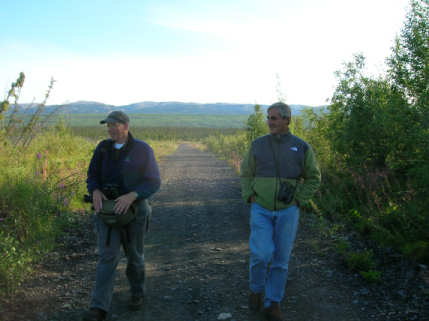 |
The earliest we could muster by Friday morning was by the 7 AM breakfast nearby at Jane's. That's how all the locals refer to the Mackenzie Valley hotel and restaurant where we were staying. It's owned and run by the efficient, organized, and wonderfully friendly Jane who seems to have become somewhat of an icon here in Norman Wells.
Like birders everywhere we had to make our pilgrimage to the town sewage lagoons. After breakfast we piled into the hotel van—loaned to us by Jane for some birding-and bounced noisily down the gravel streets to find our way to Honeypot Lane. We were not disappointed.
The willow scrub was thick with birds—the sweet chups of Yellow Warblers by the dozens, tail-wagging Palm Warblers, Ruby-crowned Kinglets, Orange-crowned Warblers, and lots of Northern Waterthrushes giving their harsh chinks whenever we pished and squeaked. A family of Eastern Kingbirds attacked a Sharp-shinned Hawk perched on the top of a dead tree, A Merlin flashed by. A Fox Sparrow sang.
The ponds themselves were full of ducks: Green-winged Teal, lots of American Wigeon, scaup (mostly Lesser I thought with a few Greaters mixed in), Mallards, and a few each of Northern Shovelers and Ring-necked Ducks.
There were a handful of shorebirds along the edges—a Pectoral Sandpiper, a pair of Lesser Yellowlegs, and a Least.
But the highlight for me was the Rusty Blackbird that Mel found. It was quietly feeding by itself under an overhanging bush along the shore. Rusties have experienced a more dramatic decline than just about any other songbird species in the last 50 years. Recent work has pegged the loss at over 95%--millions of birds fewer than 50 or a 100 years ago. Formerly a common migrant back in Maine, I hadn't seen a single one there this past spring.
Alasdair met us at 9:30 for a tour of Norman Wells. An incredibly friendly and articulate person, Alasdair is a fount of knowledge about the wildlife of the region. He arrived in Norman Wells some 12 or 13 years ago after growing up on the rocky coast of Newfoundland and studying caribou and bears in Labrador. His love of the place, the people, and the creatures of the Mackenzie Valley is evident whenever he speaks.

